
In the preservation of gross margin scenario, manufacturers are able to fully pass on this cost increase to consumers. In the preservation of gross margin percentage scenario, the increase in cashflow from the higher MSP outweighs the $239.8 in conversion costs, causing a slightly which ratio is found by dividing gross margin by sales? positive change in INPV at TSL 2 under this scenario. At TSL 1, the shipment-weighted average MPC for consumer water heaters covered by this rulemaking increases by 1.6 percent relative to the no-new-standards case shipment-weighted average MPC for all water heaters in 2030.
A. Market and Technology Assessment
At TSL 4, approximately 17 percent of consumer water heater shipments are expected to meet the required efficiency levels by the analyzed 2030 compliance date. At TSL 3, DOE estimates that impacts on INPV would range from −$391.5 million to −$39.8 million, or a change in INPV of −26.5 percent to −2.7 percent. At TSL 3, industry free cash flow is −$24.1 million, which is a decrease of $148.1 million, or a drop of 119.4 percent, compared to the no-new-standards case value of $124.0 million in 2029, the year leading up to the standards year. At TSL 3, approximately 17 percent of consumer water heater shipments are expected to meet the required efficiency levels by the analyzed 2030 compliance date. At TSL 2, DOE estimates that impacts on INPV would range from −$275.3 million to $28.2 million, or a change in INPV of −18.6 percent to 1.9 percent.
PART 429—CERTIFICATION, COMPLIANCE, AND ENFORCEMENT FOR CONSUMER PRODUCTS AND COMMERCIAL AND INDUSTRIAL EQUIPMENT
(Gas Association Commenters, No. 1181 at p. 6 and pp. 23-25) DOE acknowledges that there may be some regional variation in LCC impacts and these results are available in the LCC spreadsheet. DOE further acknowledges that some fraction of consumers will experience a net cost, as presented in the LCC. However, DOE concludes that on the whole, https://www.bookstime.com/ the rule continues to be economically justified, with the incorporation of a much larger RECS 2020 sample. With respect to low-income households, DOE took into account both scenarios where the households do or do not directly pay their utility bills, and these are included in the low-income subgroup analysis as discussed in chapter 11.

ways to improve your profitability ratios
EPCA governs and prescribes Federal preemption of State regulations as to energy conservation for the products that are the subject of this final rule. Additionally, Federal energy efficiency requirements for covered products established under EPCA, including consumer water heaters, generally supersede State laws and regulations concerning energy conservation testing, labeling, and standards. (42 U.S.C. 6297(a)-(c)) States can petition DOE for exemption from such preemption to the extent, and based on criteria, set forth in EPCA. (42 U.S.C. 6297) Therefore, no further action is required by Executive Order 13132. Therefore, based on the above considerations, DOE adopts the conservation standards for consumer water heaters at TSL 2 for those product classes where there are existing applicable UEF standards.
What Is a Good Net Profit Margin?
- However, DOE compared its seasonal marginal price factors developed from the EIA data to marginal price factors for 23 gas tariffs provided by the Gas Technology Institute for the 2016 residential boilers energy conservation standards rulemaking.
- Specifically, when evaluating TSLs, DOE considered whether the potential standards levels would likely prevent new 120-volt designs from emerging onto the market.
- (42 U.S.C. 6295(o)(2)(B)(i)(IV)) Based on data available to DOE, the standards adopted in this document would not reduce the utility or performance of the products under consideration in this rulemaking.
- DOE agrees that the product costs of heat pump water heater and condensing gas products will continue to be higher than non-condensing gas and electric resistance water heaters.
- As discussed in section IV.F.1 of this document, DOE used constant prices as the default price assumption to project future consumer water heater prices.
- DOE also expects the programs from the Inflation Reduction Act, including the appliance rebates and tax credits, would help support the expansion of this market.
As a result, today’s market continues to offer consumer water heaters that do not meet the current UEF-based standards (this is depicted in appendix 3A to the TSD). This final rule adopts amended energy conservation standards for consumer water heaters. Upon the compliance date of this final rule, the 2016 enforcement policy is terminated for all water heaters. DOE performed an MIA to estimate the impact of amended energy conservation standards on manufacturers of consumer water heaters.
What Is a Good Profit Margin?
Profit Margin

- The gross margin varies by industry, however, service-based industries tend to have higher gross margins and gross profit margins as they don’t have large amounts of COGS.
- Therefore, adding an efficiency level that corresponds to a “heat-pump only” design option as max tech would not be expected to change the UEF.
- In order to take this to account, DOE developed marginal price factors for each individual household using RECS 2015 billing data.
- Indeed, the shipments projection accounts for recent market trends that show growing consumer demand for GIWHs compared to GSWHs.
- The net change in jobs is so small that it would be imperceptible in national labor statistics and might be offset by other, unanticipated effects on employment.
- The MIA has both quantitative and qualitative aspects and includes analyses of projected industry cash flows, the INPV, investments in research and development (“R&D”) and manufacturing capital, and domestic manufacturing employment.
- DOE does not have detailed State-level data and so did not consider it in its analysis.
- Additionally, given the significantly higher Btu/h input required for instantaneous water heaters, it may be necessary to upgrade the gas line feeding the water heater to a larger diameter when switching from GSWH to GIWH.
- With respect to low-income households, DOE took into account both scenarios where the households do or do not directly pay their utility bills, and these are included in the low-income subgroup analysis as discussed in chapter 11.
- The goods would be too pricey and the company would lose clients if this weren’t done in a competitive manner.

Recent Comments